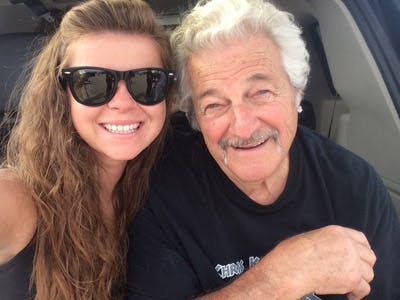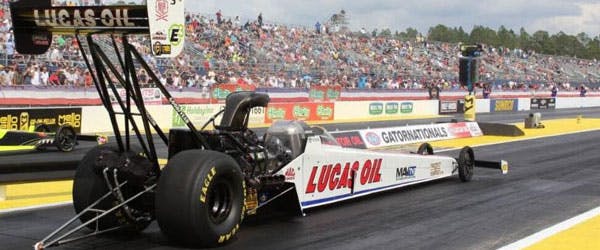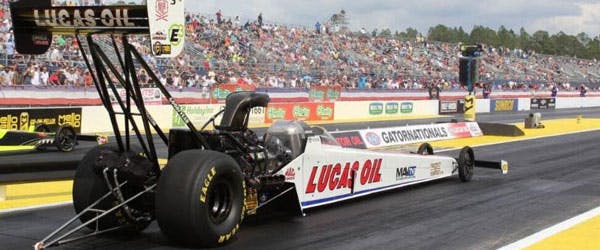Media | Articles
There will never be another racer like the NHRA’s Chris “The Greek” Karamesines

The Greek—Chris Karamesines, according to official government records—is finally retiring from drag racing at the age of 89, following the 2020 NHRA nitro racing season. He’d been chasing a life on the drag strip practically non-stop since 1954.
The Greek’s detractors used to say that because he had no big championships behind him, there wasn’t much to his career. Those kinds of people disappeared over the years while Greek rode on, knocking new talent out in eliminations whenever possible. You can almost imagine him out there twisting his mustache like Dastardly while still winning rounds after all these decades, but the truth is that there isn’t a mean bone in his body. By and large, he’s been able to race on the goodwill of dozens in the NHRA, all of whom came together to ensure that The Greek could continue to line up on any given weekend—a distinct honor given to a man who came up through drag racing’s age of discovery.
In the quest to break 200 mph, Greek and Don Garlits trade places often for “the first,” depending on what your metric is for a bonafide speed record. For The Greek, his stake for such a claim came in 1960, four years before Big Daddy secured the title with a same-day back-up run to convince the skeptics. In this period, we had only just begun defining what a dragster was, as the sport entered the golden era that ultimately settled into classes we see today.
It was a brutal process of trial and error. Today we race blown “Hemis” (which bear little relation to the production engine) fueled by nitromethane because hundreds of souls in the ’60s chased a dream to build the fastest machine between the beams of quarter-mile strips across the nation. It was a Darwin-like survival of the fittest, with hot rodders experimenting over and over until evolution delivered the Top Fuel Dragster. The powerplants back then were untamed, safety was being learned about as mistakes were made, and guys like The Greek were known for their fierce driving.
In fact, the day that Garlits secured his backed-up 200-mph run in ’64 (what some say is the first official 200mph record in drag racing), it was during eliminations against The Greek, who earlier had a parachute failure, crashing through a wire fence and ending up near the railroad track by Island Dragway in Great Meadows, New Jersey. Even before that, Greek had a reputation for powering his car back onto course and still winning rounds after hitting the dirt. This was in an era before guardrails, much less concrete barriers, were even standard practice. Four years earlier, at Alton Dragway, Greek had already broken the 200-mph mark—a 204.54 mph shot heard across the world on April 24, 1960. While today we’d think almost nothing of an 8.87 at 200-plus in a street car, this was simply untraveled territory for drag racers at the start of the 1960s. The lack of a back-up run prevented some folks from taking the run seriously, but the bar was raised that day. The performance envelope we enjoy in 2020 is on a path trailblazed by racers like The Greek.
Marketplace
Buy and sell classics with confidence
In life, The Greek hasn’t ever done anything the easy way. Despite being born in 1931, he managed to serve in World War II underaged. While in some interviews he’s claimed he was 16 when he was sent to Germany in 1945, his current age suggests that he was closer to 14. He was apparently wounded once before the motorpool injury that nearly took his life; a 10-ton wrecker slid into him, pinning his rib cage against the body of the ambulance The Greek was attempting to hook to it. Only then did he return to the United States and begin tinkering with cars, fueled by the mechanical artwork he had seen inside of the tanks and other war machines in Germany.
He began with stock car racing, which in his later drag years he claimed to be the source of his wild driving style. “It was never my intention to drive a dragster recklessly or just try to thrill people,” he stated during his induction to the NHRA’s 50 Greatest Drivers’ list. “I think the dirt racing experiences helped me. We ran a lot at Lions, and we knew that its close location to the ocean would develop dew on the surface when we raced late at night. That would make the tires spin more and caused the car to get sideways. I was able to save a lot of runs because I had more experience with that.”

As his rivals retired into their roles as team owners and celebrities, Greek kept chasing his goals. He ran vintage nitro events, making a 300-mph pass in Top Fuel (something that has become routine in these last few years of Top Fuel competition) and continuing to shake down the odd rookie of the week. As time went on, however, the community is what really began to carry The Greek to the line every weekend he wanted to run. In the last decade, as the NHRA became stricter in its enforcement of neck restraints, The Greek practically refused to buy one. Racer Jack Beckman was not about to let this be a reason The Greek retired, and he offered the veteran his HANS device until such time — which was kindly returned to Jack at Las Vegas when the season ended. Lucas Oil and Don Schumacher Racing had a pact to keep a seat for him ready, too—he wouldn’t ever have to worry about funding the operation again.
Despite the media wondering for years whether each season would really be his last, The Greek officially hung up his fire suit earlier this month. (The suit, of course, was borrowed from Funny Car racer Dale Creasy Jr. for this final event because The Greek’s was expired, and he didn’t see the need to buy a new one.) He is handing his NHRA Top Fuel seat over to his granddaughter, third-generation drag racer Krista Baldwin, who has been competing in Top Alcohol Dragster and recently earned her Top Fuel license with her grandfather watching. She’ll pilot the Lucas Oil dragster in Top Fuel while Greek deals with pressing concerns such as an impending hip surgery.
Young racers like Krista will become the chaperones of the sport. Drag racing, though matured, is in a special phase where you can still brush shoulders with the characters who molded it. One less will be in the staging lanes after this season, but he only competed as long as he did through the support of the NHRA community. When The Greek suited up and strapped in, it was a kind of immediate portal to the golden days of drag racing. That twilight era is now at an end, and even if we know there’ll never be another drag racer like him, we’re grateful for his six-plus decades of competition that inspired so many.












He is a national treasure they don’t make guys like him any more sad